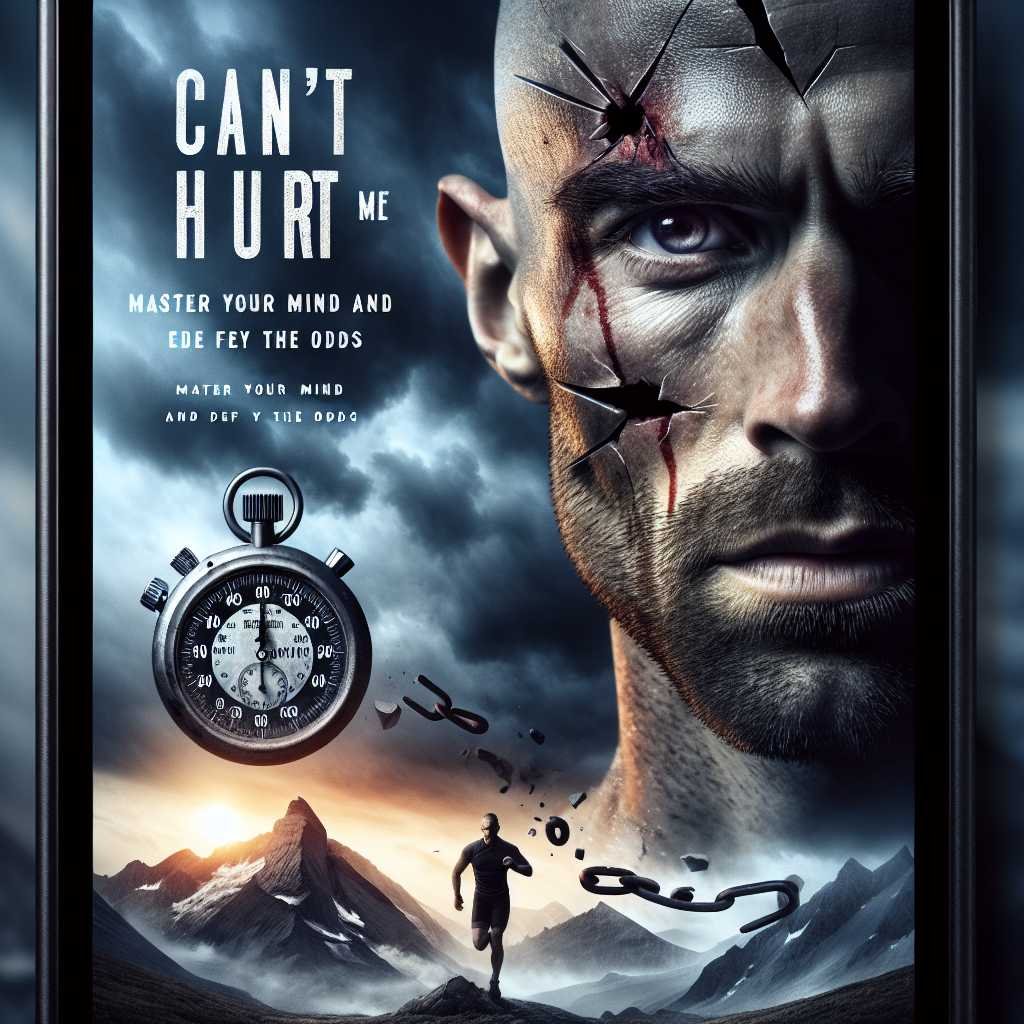Can’t Hurt Me by David Goggins: The 40% Rule, Real-World Lessons, and a Practical Kindle Reading Guide
What if the wall you keep hitting isn’t your limit—it’s the ceiling you built by accident? That’s the core provocation of Can’t Hurt Me by David Goggins, a raw memoir-meets-playbook from a man who turned trauma and self-doubt into fuel for elite performance. It’s not just a “motivation book.” It’s a blueprint for building a mind that doesn’t flinch when life pushes back.
If you’ve heard fragments of the Goggins myth—100-mile runs on wrecked feet, Hell Week repeat attempts, an all-branches special ops resume—you might think the book is just pain-bragging. It’s not. It’s a thoughtful challenge to your identity, your habits, and your assumptions about what you can tolerate. And the Kindle edition makes it easy to revisit the ideas when you’re actually in the trenches of your day.
Who Is David Goggins—and Why Does His Story Hit So Hard?
Goggins grew up under a shadow of abuse, racism, and poverty. He was overweight, aimless, and angry. But he wasn’t done. Through deliberate hardship and relentless self-honesty, he carved a path into the most demanding units in the U.S. military, including the Navy SEALs and Army Rangers (learn more about SEAL training from the U.S. Navy’s official page: navy.com/seals, Ranger Regiment information at goarmy.com, and Air Force Tactical Air Control Party at airforce.com). He later became one of the world’s top endurance athletes, with coverage in publications like Outside.
Goggins’ core message is simple but hard to internalize: most of us use only a fraction of what we’re capable of. He calls it the 40% Rule—when your mind says you’re done, you’re often at about 40% of your true capacity. The book then shows how to chip away at that invisible limit through practical challenges and mindset shifts.
Want to try it yourself—Shop on Amazon.
The Big Ideas: Mental Toughness You Can Actually Use
Can’t Hurt Me blends memoir with “challenges” at the end of each chapter. Here are the pillars.
- The 40% Rule: Your brain sets conservative safety margins. When you feel tapped out, you often have more to give.
- The Accountability Mirror: You face your reflection and write down blunt truths about your habits, goals, and excuses—daily.
- Callousing the Mind: Like hands harden with labor, your mind strengthens through repeated exposure to discomfort.
- The Cookie Jar: You stockpile past wins and hard days survived, then “reach in” during new challenges to pull out evidence you can go on.
- Taking Souls: Outwork expectations so decisively that you “take the soul” of the obstacle or opponent—psychologically flipping the script.
Here’s why that matters. You don’t need Hell Week to change. You need a structure that stretches you beyond comfort while building self-respect. Goggins’ methods are a high-grit framework for exactly that.
See today’s price—See price on Amazon.
Why the 40% Rule Works (and Where It Can Mislead)
It’s not magic. It’s your brain doing risk management. Our nervous system prioritizes survival, not flourishing. It’s quick to signal “stop” at the hint of risk or fatigue. But exposure and gradual overload recalibrate those signals. You get better at telling discomfort from danger.
- Resilience research shows that stress, when dosed and supported, can build coping capacity over time (see the American Psychological Association on resilience).
- A growth mindset—believing abilities can improve—supports persistence through setbacks; see Stanford’s work on it here.
- Recovery still matters. Endurance gains require cycles of stress and rest. Chasing intensity without rest risks injury or burnout; review physical activity basics at the CDC.
Translation: The 40% Rule is a mental unlock, not a doctor’s prescription. Use it to push when your mind balks at discomfort. Balance it with smart training, recovery, and self-awareness.
What You’ll Learn from Can’t Hurt Me (Beyond Motivation)
Identity Is a Choice—Not a Label
Goggins didn’t wait for the world to anoint him a winner. He wrote a new script—day by day. The book shows how to choose identity by choosing behaviors first. You “vote” for your future self with reps, study sessions, clean meals, early alarms. The identity follows.
Goals That Frighten You (In a Good Way)
Goggins advocates for goals that scare you into growth. Not “run 3 miles,” but “do something you’ve never done.” The trick is feasibility plus fear. Too easy, no growth. Too hard, you quit.
- Translate a stretch goal into daily inputs: time blocks, reps, meals, pages.
- Track with a visible scoreboard (whiteboard, sticky notes, digital log).
- Celebrate micro-wins. Your brain needs evidence to trust the new identity.
Build a Habit of Controlled Suffering
Controlled suffering is choosing hard, meaningful effort. It might be adding cold showers, hill sprints, or long study blocks without your phone. Goggins treats discomfort like the gym—you train it.
- Start with small “friction” daily.
- Journal cravings and emotions. Name the impulse, don’t obey it.
- Pair discomfort with purpose: “I am the type of person who does hard things.”
Use the Cookie Jar When You Want to Quit
When you hit a wall, reach for past evidence you can do hard things: job promotions, races finished, exams passed, difficult conversations handled. The point isn’t arrogance. It’s remembering your proof.
The Accountability Mirror (A Ritual That Works)
Write down the ugly truths: “I avoid phone calls.” “I eat junk at night.” “I skip speed work.” Post a plan next to each truth. Read it daily. It’s uncomfortable by design. That’s the point.
30-Day “Can’t Hurt Me” Application Plan
Not sure where to start? Try this four-week sprint. Keep it humane but serious.
Week 1: Honesty and Baseline – Do the Accountability Mirror. List five truths you’ve avoided. Pair each with one daily action. – Establish a baseline: fitness test (push-ups, 1-mile time), reading time, work block output. – Create a Cookie Jar list of 10 personal wins. Keep it handy.
Week 2: Stretch and Track – Add one daily discomfort: cold shower, incline walk, or 25% longer work block. – Track everything. Use a simple spreadsheet or notebook. Data defeats emotion.
Week 3: The 40% Reframe – Choose one session to push past the “I’m done” signal safely—add 10–20% duration or intensity. – Do one scary thing outside physical training: hard conversation, public post, application.
Week 4: Taking Souls (Ethically) – Overdeliver on one commitment at work or home. Finish early. Add unexpected value. – Reflect: What felt different? Where did you coast? Adjust the next month.
Want a tool you’ll revisit during this challenge—highlights, notes, and all? Compare formats and editions or Check it on Amazon before you buy.
The Kindle Edition: Features, Formats, and Buying Tips
If you’re considering the Kindle version, here’s what to know.
- Portability and quick re-reads: The book is dense with memorable lines and challenges. Kindle makes it easy to highlight and revisit.
- X-Ray and search: Quickly jump to people, places, and themes if supported for your edition.
- Adjustable reading: Font size, margins, and dark mode reduce eye strain.
- Synced across devices: Read on phone, tablet, or Kindle device and pick up where you left off.
- Audible pairing: If Audible narration is available for your region and edition, Whispersync can let you switch between listening and reading without losing your spot.
Choosing your format: – Kindle: Best for notes and on-the-go referencing. – Paperback/Hardcover: Tangible and giftable; easy to flip through and see full-page context. – Audiobook: Powerful for momentum; hearing Goggins amplifies the message.
Specs vary by edition and device, including page count and file size; check the product details for your region and device compatibility. Support our work by shopping here—View on Amazon.
How to Take Better Notes on Kindle
- Create a highlight system: yellow for principles, blue for stories, pink for challenges.
- Export highlights weekly and turn them into a one-page action sheet.
- Set a reminder to reread your top 20 highlights monthly.
What This Book Is—and Isn’t
It’s a battle plan for the mind. It’s also a memoir of extreme choices. Goggins’ methods aren’t for everyone, and even he warns about the cost. If you struggle with overtraining or health issues, scale the intensity. Aim for “tough but sustainable.”
If mental health challenges are part of your story, seek support; pushing alone isn’t a cure. For credible guidance, visit the National Institute of Mental Health on depression.
Ready to turn inspiration into action—Buy on Amazon.
Standout Stories You’ll Remember
- The Pest Control to SEAL Pipeline: Goggins transforms from an overweight pest control worker to a SEAL candidate through brutal honesty and relentless preparation.
- Hell Week (Again): He returns after injury and failure, embracing the pain as a forge rather than a punishment.
- The 100-Mile Test: With little training, he runs a 100-mile race to qualify for another event, learning about the true meaning of the 40% Rule in the last catastrophic miles.
- Taking Souls at Work: He reframes every obstacle as an opportunity to outperform expectations so decisively that resistance fades.
These aren’t just stunts. They’re examples of choosing the hard road on purpose, day after day.
Why Can’t Hurt Me Resonates with High Performers (and Busy Parents)
This book isn’t just for athletes or military. It’s for anyone who’s tired of stopping at the first hint of friction.
- Entrepreneurs: You’ll learn to normalize rejection and ship work anyway.
- Career changers: You’ll see how to rebuild identity by stacking disciplined days.
- Students: You’ll learn to separate discomfort (“I’m bored”) from danger (“I’m overwhelmed”).
- Parents: You’ll explore modeling resilience in small, daily ways.
And yes, it’s brutal honesty. But mixed with hope. You can build a mind that trusts you to do hard things.
Want to try it yourself without waiting for shipping—Check it on Amazon.
Related Books and Ideas to Deepen the Lessons
- Atomic Habits by James Clear: Systems and environment design to make consistency easier; explore his work at jamesclear.com.
- Grit by Angela Duckworth: The science of passion and perseverance; learn more at angeladuckworth.com.
- Endure by Alex Hutchinson: The limits of human performance and the brain’s role; see his writing at Outside.
These titles complement Goggins by adding research and tools, while his book gives you the fire to use them.
Common Mistakes People Make After Reading Can’t Hurt Me
- Going from zero to extreme: Start with sustainable challenges. Progress beats heroics.
- Ignoring recovery: Sleep, nutrition, and mobility are performance multipliers.
- Confusing suffering with productivity: The goal isn’t pain; it’s growth and competence.
- Skipping honesty: The Accountability Mirror works only if you tell the whole truth.
If you’re unsure where to begin, rerun the 30-day plan above with smaller dials. Iterate. Don’t implode.
FAQs: Can’t Hurt Me by David Goggins
Q: What is the 40% Rule in Can’t Hurt Me? A: It’s the idea that when you feel you’re at your limit, you’ve often only tapped about 40% of your capacity. It’s a mental reframe to push a bit further safely, not a literal scientific measurement.
Q: Is Can’t Hurt Me good for beginners to fitness or personal development? A: Yes—but scale it. Start with the accountability exercises and add small, controlled discomforts. Build gradually rather than mimicking Goggins’ extremes.
Q: Kindle, print, or audiobook—what’s best? A: If you want to take notes and revisit highlights, Kindle is great. If you want the emotional punch of hearing the story, audiobook hits hard. Print is ideal if you prefer to flip and annotate on paper.
Q: Is the book only for athletes or military? A: Not at all. The mental models apply to study, career pivots, parenting, and creative work. The principles are about identity, discipline, and honest self-assessment.
Q: How is this different from “soft” self-help books? A: Goggins focuses less on mindset platitudes and more on doing hard things daily. It’s action-first. The tone is intense, but the practices are practical.
Q: How do I avoid overtraining while using Goggins’ ideas? A: Use progressive overload, plan rest days, and track data. If you feel pain rather than effort, back off. Follow guidelines like those from the CDC and consult a professional if needed.
Q: What are the “challenges” at the end of each chapter? A: They’re practical assignments—like the Accountability Mirror, creating a Cookie Jar list, or scheduling controlled discomfort—that help you translate the book into action.
The Bottom Line
Can’t Hurt Me is a wake-up call disguised as a memoir. It argues that your limits are often psychological speed bumps, not brick walls. Read it for the stories, keep it for the systems: the 40% Rule, the Accountability Mirror, the Cookie Jar, and the art of taking souls. Then run your own experiments—small, daily, and honest.
If this breakdown helped, keep exploring high-signal book guides and practical playbooks—subscribe or check out our latest reviews so you can keep building a mind that meets hard days head-on.
Discover more at InnoVirtuoso.com
I would love some feedback on my writing so if you have any, please don’t hesitate to leave a comment around here or in any platforms that is convenient for you.
For more on tech and other topics, explore InnoVirtuoso.com anytime. Subscribe to my newsletter and join our growing community—we’ll create something magical together. I promise, it’ll never be boring!
Stay updated with the latest news—subscribe to our newsletter today!
Thank you all—wishing you an amazing day ahead!
Read more related Articles at InnoVirtuoso
- How to Completely Turn Off Google AI on Your Android Phone
- The Best AI Jokes of the Month: February Edition
- Introducing SpoofDPI: Bypassing Deep Packet Inspection
- Getting Started with shadps4: Your Guide to the PlayStation 4 Emulator
- Sophos Pricing in 2025: A Guide to Intercept X Endpoint Protection
- The Essential Requirements for Augmented Reality: A Comprehensive Guide
- Harvard: A Legacy of Achievements and a Path Towards the Future
- Unlocking the Secrets of Prompt Engineering: 5 Must-Read Books That Will Revolutionize You







